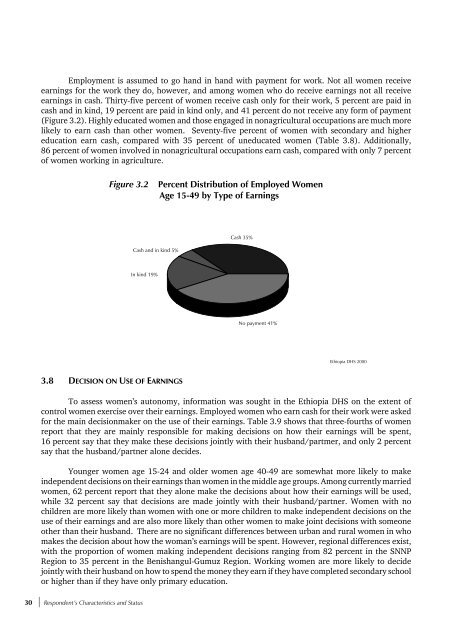PDF, 1536K - Measure DHS
PDF, 1536K - Measure DHS
PDF, 1536K - Measure DHS
You also want an ePaper? Increase the reach of your titles
YUMPU automatically turns print PDFs into web optimized ePapers that Google loves.
Employment is assumed to go hand in hand with payment for work. Not all women receive<br />
earnings for the work they do, however, and among women who do receive earnings not all receive<br />
earnings in cash. Thirty-five percent of women receive cash only for their work, 5 percent are paid in<br />
cash and in kind, 19 percent are paid in kind only, and 41 percent do not receive any form of payment<br />
(Figure 3.2). Highly educated women and those engaged in nonagricultural occupations are much more<br />
likely to earn cash than other women. Seventy-five percent of women with secondary and higher<br />
education earn cash, compared with 35 percent of uneducated women (Table 3.8). Additionally,<br />
86 percent of women involved in nonagricultural occupations earn cash, compared with only 7 percent<br />
of women working in agriculture.<br />
Figure 3.2 Percent Distribution of Employed Women<br />
Age 15-49 by Type of Earnings<br />
Cash and in kind 5%<br />
Cash 35%<br />
In kind 19%<br />
No payment 41%<br />
Ethiopia <strong>DHS</strong> 2000<br />
3.8 DECISION ON USE OF EARNINGS<br />
To assess women’s autonomy, information was sought in the Ethiopia <strong>DHS</strong> on the extent of<br />
control women exercise over their earnings. Employed women who earn cash for their work were asked<br />
for the main decisionmaker on the use of their earnings. Table 3.9 shows that three-fourths of women<br />
report that they are mainly responsible for making decisions on how their earnings will be spent,<br />
16 percent say that they make these decisions jointly with their husband/partmer, and only 2 percent<br />
say that the husband/partner alone decides.<br />
Younger women age 15-24 and older women age 40-49 are somewhat more likely to make<br />
independent decisions on their earnings than women in the middle age groups. Among currently married<br />
women, 62 percent report that they alone make the decisions about how their earnings will be used,<br />
while 32 percent say that decisions are made jointly with their husband/partner. Women with no<br />
children are more likely than women with one or more children to make independent decisions on the<br />
use of their earnings and are also more likely than other women to make joint decisions with someone<br />
other than their husband. There are no significant differences between urban and rural women in who<br />
makes the decision about how the woman’s earnings will be spent. However, regional differences exist,<br />
with the proportion of women making independent decisions ranging from 82 percent in the SNNP<br />
Region to 35 percent in the Benishangul-Gumuz Region. Working women are more likely to decide<br />
jointly with their husband on how to spend the money they earn if they have completed secondary school<br />
or higher than if they have only primary education.<br />
30 * Respondent’s Characteristics and Status








![Obtaining Informed Consent for HIV Testing [QRS4] - Measure DHS](https://img.yumpu.com/49850117/1/190x245/obtaining-informed-consent-for-hiv-testing-qrs4-measure-dhs.jpg?quality=85)








